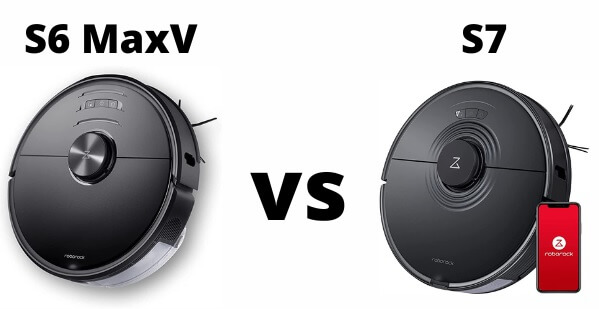In this article we compare the Roborock S6 MaxV to the Roborock S7. Both models are great robot vacuums, but we believe the S6 MaxV is the better option overall.
Table of Contents
Design Differences
The biggest difference between the S6 MaxV and the S7 lies around the robot’s brushroll, brushroll compartment and the dustbin seated right above it.
The S6 MaxV features a more standard design. Its brush hole has flaps and bristles to help pick up debris.
Its dust bin is rectangular in shape with a volume of 460 milliliters and no outlet for self-emptying.
The S7’s brushroll, brushroll compartment and dustbin have been completely redesigned. Its brushroll features a bristles design, its dust bin is more square in shape with a volume of 470 milliliters and dedicated space for an outlet for self-emptying.
Self-Empty Docl Compatibility
This leads us right into the second big difference between the S6 MaxV and the S7, self-empty dock compatibility.
The S6 MaxV with its more traditional design is not compatible with the Roborock auto empty dock. The S7 redesign is what allows for compatibility with the Roborock auto empty dock.
Power Differences
Another big difference between the S6 MaxV and S7 involves each model’s raw performance.
The S6 MaxV has a measured airflow of 16 CFM and a measured suction of 0.27 kPa. The S7 has a measured airflow of only 12 CFM and a measured suction of only 0.07 kPa.
Deep Clean Differences
Another difference involves each robot’s carpet deep cleaning ability.
The S6 MaxV picked up 6 grams of 30 grams of fine debris in our carpet deep clean test. The S7 picked up only 3 grams in the same test under the same conditions.
Mopping Differences
Yet another difference between these models involves mopping functionality.
The S6 MaxV once again features a fairly standard design. It comes with a standard mop attachment and a reservoir that fits into the robot and drips water onto this attachment.
The S7 has the same basic design but adds extra features. Its mop attachment vibrates and is able to lift slightly off the ground when the robot crosses carpet.
Our testing shows that neither one of these additional features is all that useful though. Vibration made no difference at all in our mopping test.
Both robots cleaned the test surface equally well in this test.
The S7 being able to lift its mop when crossing rugs or carpet is only marginally useful. The mop lifts only five millimeters off the ground, so this feature is only really useful for very low pile rugs and carpet.
Most users will still want to use no mop zones to ensure the robot doesn’t have any issues with rugs or carpet while mopping. That feature is also available with the S6 MaxV.
The bottom line is that the S6 MaxV lacks some extra mopping features, but in practice using either robot for mopping should result in a very similar experience.
Small Obstacle Detection and Avoidance
Another much more meaningful difference between these models involves small obstacle detection and avoidance.
The S6 MaxV has two front-facing cameras, which allows it to detect and avoid small obstacles like shoes and pet waste.
The S7 does not have these cameras and so it cannot detect or avoid small obstacles. It runs right over and so can much more easily get stuck on smaller obstacles.
The last difference of note between these two models involves noise output. Both robots have similar noise output on default power, but the S7 can get slightly quieter on lower power settings, and gets considerably louder on its highest power setting.
Cleaning Modes
In most other aspects these two robots are remarkably similar.
They both pick up surface level debris on carpet very well and they both pick up surface level debris on hard floors very well.
Both robots feature very similar padding around edges and both get sufficiently close to edges to clean them very well.
Both robots picked up long hair well enough in our hair pickup testing, but 70 to 90 percent of the hair they picked up tangled around their brushrolls.
We expected the S7 to perform better in this test because of its brushrolls bristles design, but it did not. It tangled just as much with longer hair, though it was easier to pull hair off of its brushroll because of its bristles design.
Both robots didn’t tangle at all with the shorter hair used for our pet hair pickup test. They both pulled all of the hair they picked up in this test into their dustbins.
Both robots also feature almost identical general navigation and coverage.
Neither robot had any trouble navigating around larger obstacles, like table legs and chair legs, though the S6 MaxV is able to detect and avoid small obstacles, while the S7 cannot as was mentioned earlier.
You use the exact same app to control either robot and functionality within the app is much the same for both robots.
Both robots have the same battery size and run time and both robots are the same size with a diameter of 13 and a half inches and a height of 4 inches.
General Recommendations
When it comes to general recommendations, we feel the S6 MaxV is the better robot vacuum overall.
It deep cleans carpet better and it’s able to avoid smaller obstacles like shoes, socks and pet waste, while the S7 cannot
The S7 is still a good robot vacuum though and it is compatible with the Roborock auto empty dock, while the S6 MaxV is not.
So if this functionality is important to you, we do recommend the S7 over the S6 MaxV.

